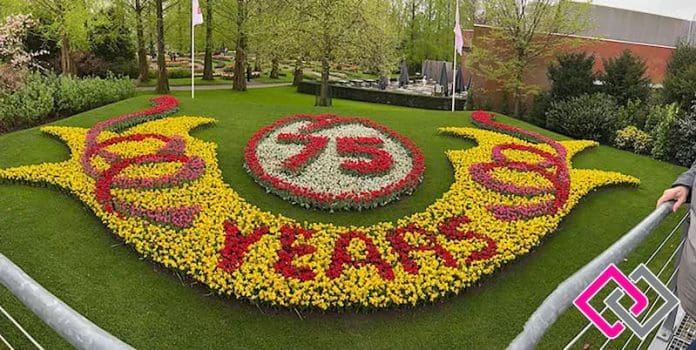We’ve finally arrived at the final article on the Warner’s adventure to Switzerland, Germany, France, and the Netherlands the first week of April so you can put away any sharp instruments knowing that you have survived the recounting of the trip. The last third of the Rhine River expedition found the Viking Rolf arriving in Cologne, Germany’s fourth largest city. Cologne, or Koln as the locals prefer, is an intriguing mix of old and new revealing its Roman heritage in its city layout and the ancient ruins that lie scattered through the town.
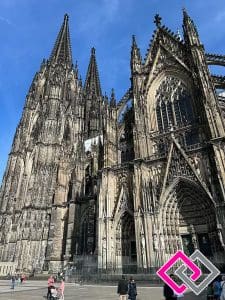
A few things were particularly memorable beginning with the famous Cologne Cathedral, a designated World Heritage Site. Begun in 1248, it took nearly seven centuries to complete and was the tallest building in the world until 1885. Overlooking a magnificent central plaza, the twin spires of the Cathedral reach a height of 515’ (what structure reached a greater height to overtake the Cathedral you ask? How about the Washington Monument which was purposely designed to be taller!). The Cathedral also famously houses the supposed bones of the Magi, the three kings who paid homage to the infant Jesus (any souvenir shop around the plaza will sell you pieces of said bones!).
The central area of this large metropolitan city is once again mostly pedestrian featuring not only local shops but also retail stores from around the world not to mention such gastronomic delights as McDonalds, KFC, Pizza Hut, Burger King, Starbucks, and a Dunkin Donuts on seemingly every other block!
A traditional part of Cologne life is the tasty Kolsch bier, brewed by over 20 establishments and served at your table in small, slender glasses. Upon finishing a serving, a waiter immediately arrives with another, marking your coaster each time to keep a tab—if you don’t want anymore you simply place your coaster on top of your empty glass. Enough of those small glasses can evidently be quite fulfilling!!
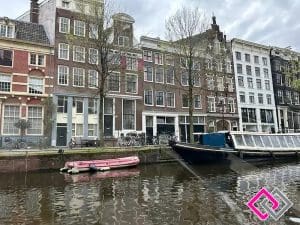
The Cologne waterfront is spectacular, particularly at night as the Rolf set sail for the Netherlands. Before sailing we listened to a lecture by a German professor about life in modern Germany which was really interesting. Like most developed countries the Deutschland is facing a shortage of skilled labor as well as housing as the workforce ages. Housing takes up 38% of the average family’s budget but is offset by low transportation (like most European countries the German public transit system is marvelous) and health care costs (financed mainly by a tax based on family income and size).
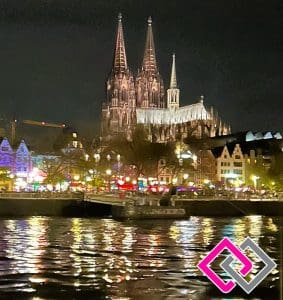
Germany is still struggling with integrating what was East Germany with the Western part, even after all of these years since the fall of the Berlin Wall, mainly due to a different mindset following years of communist rule in the East. Also, the Germans are finding themselves somewhat dependent on immigrants to fill work positions, with accompanying problems of different natures. An amusing fact brought up was that the Germans take great pride in the quality and varieties of their breads and rolls—they can’t understand how Americans can like bread that can be mashed down like a marshmallow!
As we cruised into the Netherlands the surrounding countryside flattened out, mainly because almost half of the country has been reclaimed from the sea and is up to 12.5’ below sea level. The Netherlands, or Holland as it is sometimes called even though Holland is just a region of the country, is about half the size of Indiana and has 17 million inhabitants.
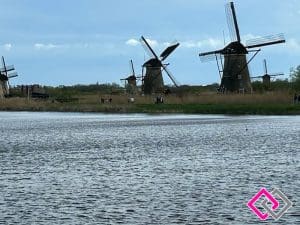
Our first stop was at Kinderdijk and the site of 19 windmills (think Hans Brinker, wooden shoes, the little boy with his finger in the dike, etc). The windmills were once, and to some extent still are but mostly for tourists, used to move water into canals and then into the North Sea allowing the ground to dry. The Dutch have become the world’s foremost authorities on water management with innovative systems of dikes, canals, seawalls, etc. An interesting fact is that the country needs rain to keep the reclaimed soil moist or it dries into a powder and crumbles along with any structure built upon it!
Our final night on the Rolf was spent in the capital city of Amsterdam, although the government is located in The Hague. After disembarking for a final time we checked into the Movenpick Hotel for a two night stay on the main channel of Amsterdam where we enjoyed a never ending parade of cargo ships, cruise ships, and ferries from our fourteenth floor windows. Amsterdam is a city of almost 800,000 residents and is everything that you’ve imagined —over 165 canals covering 60 miles with 1,281 bridges, over 2,500 docked houseboats, 50-some museums, quaint neighborhoods overlooking canals (if you have to ask what the houses on the canals cost you probably can’t afford them!), restaurants, plazas, the Red Light District (Kathy decided we didn’t need to go there!), fine shopping, flowers everywhere, and friendly people.
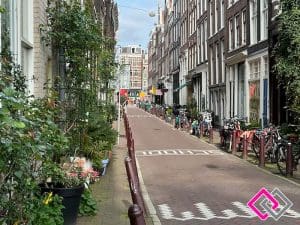
An interesting fact is that there are over 880,000 bicycles in Amsterdam—cyclists have the right of way and woe to any who get caught in their path! It was interesting to see the different styles of bikes and to see elderly people, little kids, and business people in suits all pedaling around town without a care in the world knowing they owned the roads! Also it was stated that over 10,000 bikes are found in the canals yearly—the canals are drained to the sea every quarter and refilled to avoid stagnation.
One last excursion took us to the famed Keukenhof Gardens about an hour outside of Amsterdam. One reason we took this trip in early April was to see the 79 acres of “the world’s most spectacular flower display” with over seven million tulip bulbs in full bloom for a period of six weeks or so. Even to someone like myself who has trouble distinguishing a rose from a carnation the Gardens was truly impressive. Bulbs and cut flowers are shipped all over the world and are one of the area’s main sources of revenue.
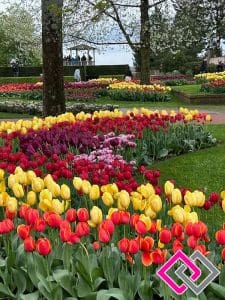
We could have stayed much longer in Amsterdam but it was time to head home so we boarded an United Airlines 787 out of the world’s third busiest international connecting airport at 2:00 p.m. for the long flight back to Chicago, arriving at 3:00 p.m. Central Daylight Time. After passing through US Customs (impressively efficient this time after a disastrous experience a few years ago, an over two-hour ordeal) we had a short layover at O’Hare before taking a regional jet to Dayton, arriving back on good Darke County soil around 10:00–it’s always good to sleep in your own bed!
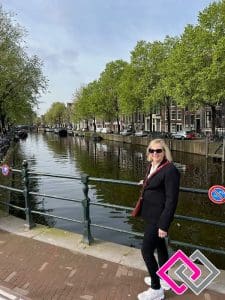
Thanks for taking the time to read this account of our journey—we had a great time, saw many well-known sites along with a few pleasant surprises, met a lot of interesting people, and would highly recommend it and Viking Cruise Line to anyone with a taste for travel. Stay active and healthy!!




